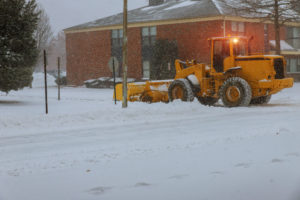A Guide to Completing Concrete Work in the Cold

Completing concrete work in any weather can be complicated. Once it gets colder outside, though, the process can be even more difficult.
Completing concrete work in any weather can be complicated. Once it gets colder outside, though, the process can be even more difficult. That’s why contractors and work crews need to stay on their toes whenever the concrete they are working on have been exposed to snow, ice, frost, and freezing rain. Here now is a guide to how you can finish your tasks while avoiding some easy-to-make mistakes, such as the following.
Laying the Concrete on Already-Frozen Ground
The first frost of the season has come and gone but it’s only going to get worse from here on out. One of the biggest mistakes you can make when it comes to working with concrete is where you lay it down. In other words, don’t put the concrete on any ground that has already frozen up. That’s because once the frozen ground begins to thaw, it will then settle. Although this doesn’t sound like a problem, it can lead to cracks forming. There’s also a threat to the integrity of the slab based on how the top of the concrete block will cure faster than the bottom.
Letting the Concrete Freeze
Likewise, you cannot allow the concrete mixture to freeze. Part of the curing process involves keeping the concrete relatively warm. After all, still-fresh concrete can freeze extremely quickly – its freezing point is only 25 degrees Fahrenheit, so you’ll need to maintain a 50-degree minimum. Using a temperature and maturity meter to measure the warmth of the concrete is a wise choice.
Not Warming Up Your Tools
Along those same lines, be sure to warm up the tools and equipment you plan on using. All tools and building materials should be kept at the same warm temperature as the concrete you are attempting to cure; otherwise, you could end up unintentionally weakening the slab.
Concrete Sealing Mishaps
Sealers can protect all of your concrete assets in frigid temperatures. Follow all of the recommendations set forth by the producer or manufacturer of the sealant that you choose. Also, don’t apply the sealer if it is too cold outside.
Not Accounting for Daylight
There are fewer hours of daylight, which means it gets dark much faster than in the spring or summer. That’s why you need to account for how much sunlight you still have. Falling behind schedule is never a good thing, and you do not want to upset your client in this manner.
Revitalize Your Business with G&M Services
G&M Services is proud of our employees and the dedication they have for safety in the workplace. We reward our employees for displaying positive safety practices. We incorporate weekly and monthly discussions and meetings to ensure that all involved are aware of how to handle equipment and potential situations that could occur during a project.
G&M Services offers services in the way of concrete drilling and sawing, concrete scanning, and Firestop. To get started with us, call today at 410-787-8828 or visit our contact page. Follow the official company page today on Facebook, Twitter, and LinkedIn.








